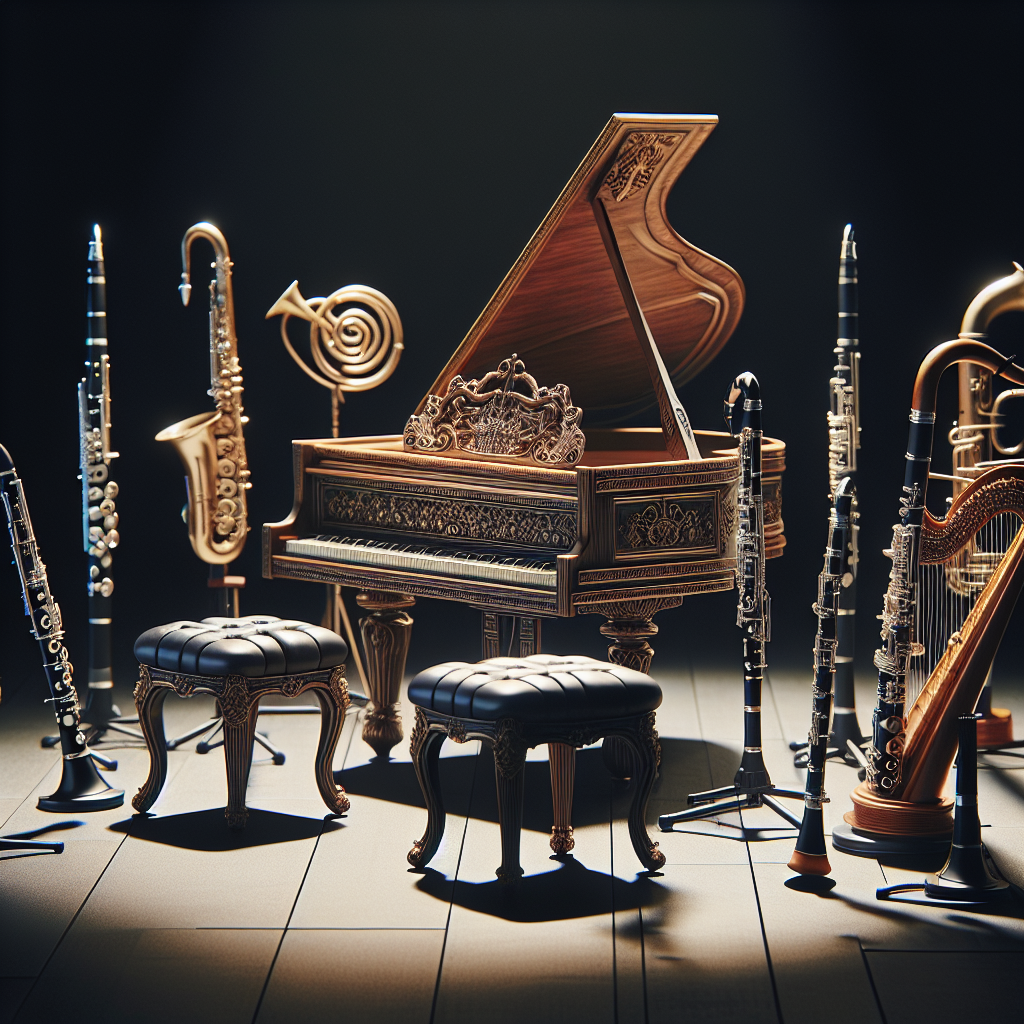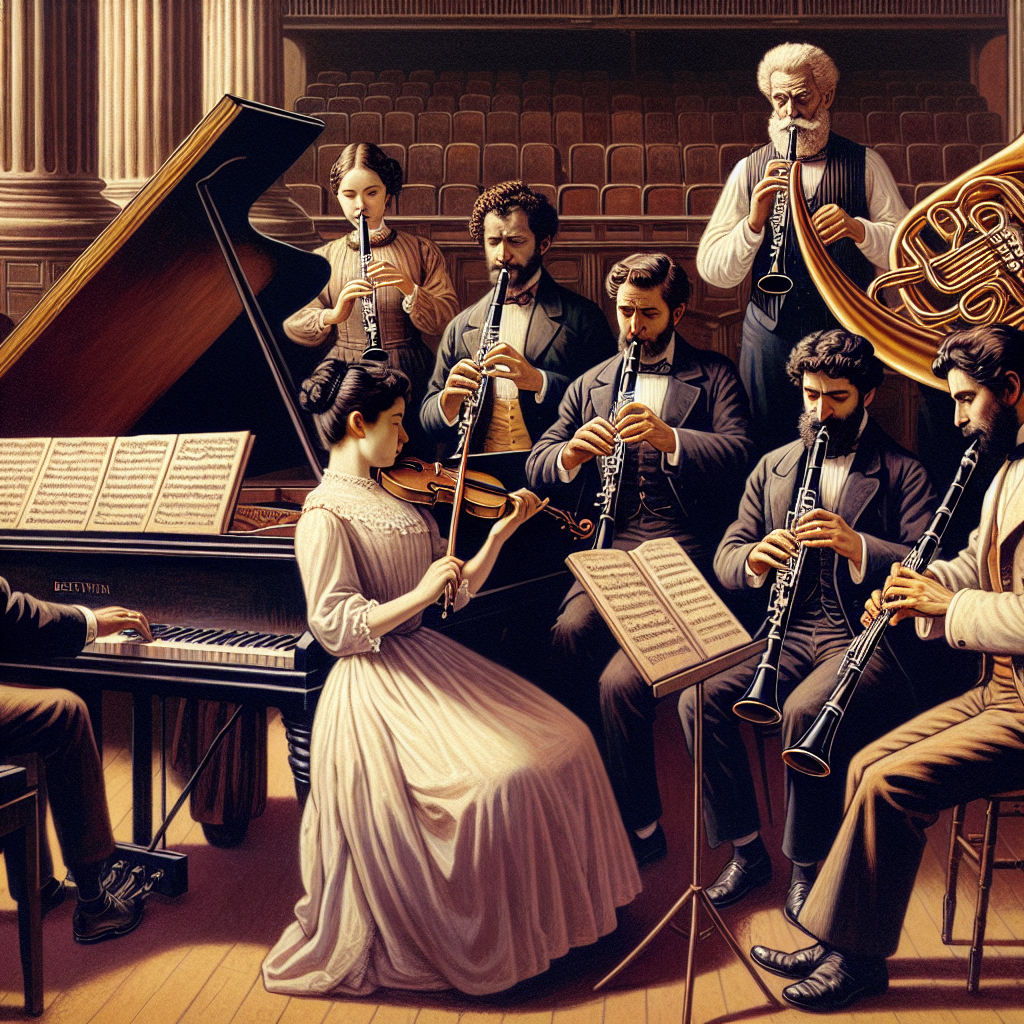
Beethoven’s Quintet for Piano and Winds: A Unique Ensemble
Ludwig van Beethoven, one of the foremost composers of classical music history, is known for his groundbreaking works that span various musical genres. While his contributions to symphonies, sonatas, and concertos are widely celebrated, his chamber music, particularly the Quintet for Piano and Winds, Op. 16, merits a special mention. This ensemble piece, composed in Beethoven’s early period, blends the strengths of both piano and wind instruments to create a unique and engaging musical narrative. In the realm of chamber music, where string quartets often steal the spotlight, Beethoven’s exploration with wind instruments stands out as an innovative endeavor worth delving into.
The Quintet for Piano and Winds, Op. 16, was composed in 1796, during a time when Beethoven was rapidly gaining recognition for his virtuosity and compositional prowess. This was also a period marked by experimentation and expansion of the classical form, influenced by luminaries like Mozart and Haydn. However, Beethoven distinguished himself with his bold structural and harmonic ideas, infusing his works with rich emotional depth and dynamic contrasts.
This article takes a comprehensive look at Beethoven’s Quintet for Piano and Winds, examining its historical context, structural elements, specific movements, and its legacy in the world of chamber music. Through this exploration, we gain a deeper appreciation of Beethoven’s ingenuity and how he elevated the ensemble of piano and winds to an extraordinary level.
Historical Context
The late 18th century was an era of transformation and innovation in the Western musical tradition. Beethoven, born in December 1770, grew up during the vibrant ease from the Baroque to the Classical period, absorbing the essences of each to develop his distinctive style. Composed in 1796, the Quintet for Piano and Winds comes from Beethoven’s early Vienna years, a period characterized by his immersion amongst musical greats and his ambitions to carve out a name for himself in the bustling artistic metropolis.
Vienna during the late 1700s was the musical epicenter of Europe, teeming with talents and patrons of the arts. Beethoven, having moved from Bonn to Vienna in 1792, aimed higher under the tutelage of Joseph Haydn, though their relationship quickly turned cold. Nevertheless, Beethoven’s creative output surged, and he networked tirelessly among the nobility and elite musicians of his time.
Influences from contemporaries, especially Wolfgang Amadeus Mozart, played pivotal roles in shaping Beethoven’s early compositions. Mozart’s Quintet for Piano and Winds, K. 452, composed in 1784, was a direct inspiration for Beethoven’s Op. 16. While drawing from Mozart’s foundation, Beethoven introduced more distinctive dramatic contrasts and harmonic explorations, utilizing the rich sonorities of the wind instruments intertwined with the piano’s expressive capacity.
The Quintet, with its novel instrumentation that was relatively rare for the period, not only showcased Beethoven’s originality but also demonstrated his skill in creating balanced dialogues between the piano and the four wind instruments—oboe, clarinet, bassoon, and horn. Beethoven’s aim appeared to be not just to adhere to the prevailing styles but to challenge and extend the musical expressions of his time.
Structure and Movements
Beethoven’s Quintet for Piano and Winds, Op. 16, is structured into three distinct movements, showcasing his masterful command over form and thematic development. Each movement offers a unique exploration into the capabilities of the piano and wind ensemble.
The first movement, labeled ‘Grave – Allegro ma non troppo,’ opens with a slow, solemn introduction that sets a serious tone. This gravitas soon gives way to the spirited allegro, where Beethoven deftly navigates between playful themes and more reflective passages. The interaction between the piano and winds is highly conversational, with the piano introducing themes that the winds echo and elaborate upon. This movement exemplifies Beethoven’s ability to shift moods effortlessly, maintaining listener engagement through dynamic contrasts.
The second movement, ‘Andante cantabile,’ offers a lyrical respite with its serene and melodic lines. Here, Beethoven allows the winds to take more lead in presenting the themes, supported by the gentle and often subduous piano accompaniment. The melodic exchanges between the instruments create a pastoral and contemplative atmosphere, showcasing Beethoven’s gift for lyrical beauty.
The final movement, ‘Rondo: Allegro ma non troppo,’ resumes the vivacity of the first movement with a rondo form. The recurring main theme is jaunty and festive, inviting episodes of exuberance and wit. Beethoven injects a sense of joy and dance, balancing intricate counterpoints with memorable melodies. The coda wraps the quintet with a flourish, ensuring the composition ends on a high and triumphant note.

Instrumentation
The instrumentation of the Quintet for Piano and Winds provides a fascinating lens through which we can appreciate Beethoven’s innovative use of timbre and texture. Each instrument in the quintet—piano, oboe, clarinet, bassoon, and horn—brings its own distinctive sound and character to the ensemble, contributing to the overall richness and variety of the music.
The piano, with its wide expressive range, serves as the cornerstone of the ensemble, anchoring the harmonic structure while interacting fluidly with the wind instruments. Beethoven exploits the piano’s percussive and lyrical potentials, often juxtaposing brisk passages with more flowing, song-like lines.
The oboe, known for its piercing and somewhat nasally tone, adds a sharp brightness that can convey both plaintive and playful moods. It is often tasked with presenting melodies, owing to its clarity in articulation.
The clarinet, with its greater dynamic range and smoother timbre, complements the oboe while offering a contrasting warmth. Its agility and wide range allow it to ebb and flow seamlessly between the background and the foreground.
The bassoon, which produces a deeper, reedy sound, serves as the ensemble’s anchor, often providing the basslines and harmonic underpinning. Its versatility is formidable, capable of comedic staccatos as well as more serious, sustained tones.
The horn, with its noble and resonant tone, adds an element of grandeur and often highlights climactic moments. Its ability to play both harmonic and melodic roles further enriches the overall texture of the quintet.
Interpretation and Performance
Performing Beethoven’s Quintet for Piano and Winds requires not just technical precision but also a profound understanding of the dialogue and interplay that Beethoven intended. Modern-day interpretations vary, with some ensembles opting for a more historically informed approach using period instruments, while others prefer the nuances and capabilities of modern instruments.
Historically informed performances aim to reproduce the sound world of Beethoven’s time, using instruments that closely resemble those from the late 18th century. This often results in a brighter, more transparent sound, and can bring listeners closer to the soundscapes that Beethoven himself might have envisioned.
Conversely, performances with modern instruments take advantage of advancements in instrument construction that offer greater dynamic range and technical facility. These interpretations can reveal new layers of expression and expand the dramatic capabilities of the music.
Regardless of the approach, successful performances hinge on the ensemble’s ability to communicate and blend their timbres effectively. The quintet’s conversational nature demands attentiveness and responsiveness among players, ensuring that melodic lines and thematic exchanges are delivered with clarity and emotional impact.
Legacy and Influence
Beethoven’s Quintet for Piano and Winds has left a lasting legacy, influencing subsequent generations of composers and solidifying its place in the chamber music repertoire. By demonstrating the viability of a piano and wind ensemble, Beethoven opened the door for later composers to explore similar combinations and expand the chamber music genre.
Composers such as Franz Danzi, Sigismund von Neukomm, and even Richard Strauss were inspired by Beethoven’s efforts, creating their own works for similar instrumentations. The quintet format that Beethoven explored proved to be a fertile ground for creative experimentation, allowing for rich textural and harmonic interplay.
In the modern era, the quintet continues to be a beloved piece among chamber musicians and a staple in concerts and recordings. The blend of piano and winds offers a refreshing contrast to the more ubiquitous string quartets, bringing diversity to chamber music programming.
Educational institutions often feature the quintet in their curriculum, using it to teach students about ensemble playing, balance, and the intricacies of chamber music interpretation. It remains a testament to Beethoven’s genius that his works, over two centuries later, continue to resonate deeply with both performers and audiences alike.
Conclusion
Ludwig van Beethoven’s Quintet for Piano and Winds, Op. 16, stands as a seminal work in the composer’s chamber music oeuvre. Its historical context, structural elegance, and innovative use of instrumentation highlight Beethoven’s genius in pushing the boundaries of the classical form. By creating a balanced and dynamic dialogue between the piano and wind instruments, Beethoven not only paid homage to his predecessors but also carved a unique niche that continues to inspire and captivate.
The quintet serves as a microcosm of Beethoven’s broader artistic journey—a blend of reverence for tradition and a relentless pursuit of innovation. Through its three movements, listeners experience a rich tapestry of moods, from solemnity and lyricism to exuberance and triumph. Each instrumental voice is given its place to shine, contributing to the ensemble’s overall seamless cohesion and dramatic storytelling.
As performers and scholars revisit this work, new interpretations and understandings continue to emerge, ensuring the quintet’s relevance and vitality in the modern era. Whether performed on period instruments or through the lens of contemporary techniques, Beethoven’s Quintet for Piano and Winds remains a timeless exemplar of the transformative power of music.
In sum, Beethoven’s foray into the realm of piano and winds through Op. 16 not only marks a milestone in his own compositional development but also enriches the broader landscape of chamber music. Its enduring legacy is a testament to Beethoven’s unparalleled genius and his uncanny ability to touch the human spirit through the universal language of music.